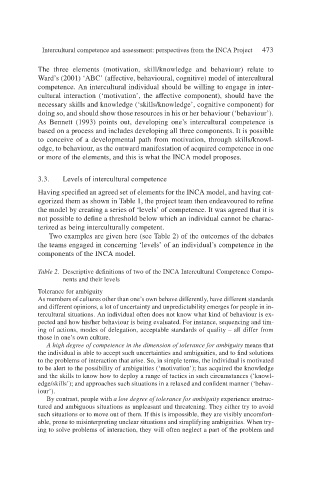Page 495 - Handbooks of Applied Linguistics Communication Competence Language and Communication Problems Practical Solutions
P. 495
Intercultural competence and assessment: perspectives from the INCA Project 473
The three elements (motivation, skill/knowledge and behaviour) relate to
Ward’s (2001) ‘ABC’ (affective, behavioural, cognitive) model of intercultural
competence. An intercultural individual should be willing to engage in inter-
cultural interaction (‘motivation’, the affective component), should have the
necessary skills and knowledge (‘skills/knowledge’, cognitive component) for
doing so, and should show those resources in his or her behaviour (‘behaviour’).
As Bennett (1993) points out, developing one’s intercultural competence is
based on a process and includes developing all three components. It is possible
to conceive of a developmental path from motivation, through skills/knowl-
edge, to behaviour, as the outward manifestation of acquired competence in one
or more of the elements, and this is what the INCA model proposes.
3.3. Levels of intercultural competence
Having specified an agreed set of elements for the INCA model, and having cat-
egorized them as shown in Table 1, the project team then endeavoured to refine
the model by creating a series of ‘levels’ of competence. It was agreed that it is
not possible to define a threshold below which an individual cannot be charac-
terized as being interculturally competent.
Two examples are given here (see Table 2) of the outcomes of the debates
the teams engaged in concerning ‘levels’ of an individual’s competence in the
components of the INCA model.
Table 2. Descriptive definitions of two of the INCA Intercultural Competence Compo-
nents and their levels
Tolerance for ambiguity
As members of cultures other than one’s own behave differently, have different standards
and different opinions, a lot of uncertainty and unpredictability emerges for people in in-
tercultural situations. An individual often does not know what kind of behaviour is ex-
pected and how his/her behaviour is being evaluated. For instance, sequencing and tim-
ing of actions, modes of delegation, acceptable standards of quality – all differ from
those in one’s own culture.
A high degree of competence in the dimension of tolerance for ambiguity means that
the individual is able to accept such uncertainties and ambiguities, and to find solutions
to the problems of interaction that arise. So, in simple terms, the individual is motivated
to be alert to the possibility of ambiguities (‘motivation’); has acquired the knowledge
and the skills to know how to deploy a range of tactics in such circumstances (‘knowl-
edge/skills’); and approaches such situations in a relaxed and confident manner (‘behav-
iour’).
By contrast, people with a low degree of tolerance for ambiguity experience unstruc-
tured and ambiguous situations as unpleasant and threatening. They either try to avoid
such situations or to move out of them. If this is impossible, they are visibly uncomfort-
able, prone to misinterpreting unclear situations and simplifying ambiguities. When try-
ing to solve problems of interaction, they will often neglect a part of the problem and

